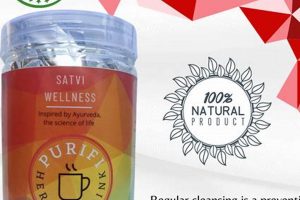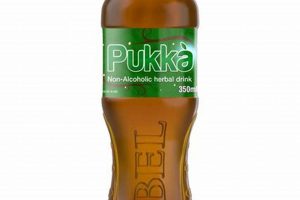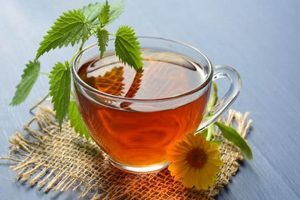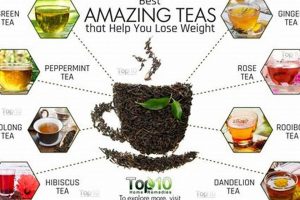Beverages marketed as alternatives to traditional caffeinated products frequently incorporate plant-derived ingredients believed to promote alertness and stamina. These formulations often feature extracts from herbs, roots, and fruits, aiming to provide a boost without the potentially harsh effects associated with high doses of synthetic stimulants. A common example includes beverages containing guarana, ginseng, or yerba mate, often combined with natural sweeteners and fruit juices.
The appeal of these revitalizing beverages stems from a perceived health benefit and a desire for sustained vitality. Historically, many cultures have utilized botanical remedies for their invigorating properties. Modern formulations seek to harness this traditional knowledge, offering consumers a potentially gentler and more natural way to enhance energy levels. This approach resonates with individuals seeking alternatives to conventional energy supplements, contributing to the increasing popularity of plant-based options.
This article will delve into the specific botanical components commonly found in these beverages, examining their purported mechanisms of action and exploring the available scientific evidence supporting their efficacy. Further analysis will address potential safety considerations and explore the regulatory landscape surrounding the production and marketing of these products. The objective is to provide a balanced and evidence-based overview, allowing consumers to make informed choices regarding their energy beverage consumption.
Guidance on Selecting and Consuming Plant-Based Vitality Beverages
The following recommendations offer guidance for individuals considering incorporating plant-based vitality beverages into their routines. These suggestions emphasize informed choices and responsible consumption.
Tip 1: Scrutinize Ingredient Lists: Thoroughly examine the ingredient lists, paying close attention to the specific botanical extracts used, their concentrations, and the presence of added sugars or artificial additives. Understanding the composition is crucial for making informed decisions.
Tip 2: Research Individual Ingredients: Conduct independent research on the purported effects and potential side effects of the specific herbs and botanicals present. Reputable sources of information include scientific studies, academic institutions, and government health agencies.
Tip 3: Be Mindful of Caffeine Content: While often perceived as gentler than synthetic stimulants, some plant-based formulations may still contain significant amounts of caffeine, either naturally occurring or added. Monitor intake to avoid exceeding recommended daily limits.
Tip 4: Consider Potential Interactions: Individuals taking prescription medications or with pre-existing health conditions should consult with a healthcare professional before consuming these beverages. Certain herbal ingredients may interact with medications or exacerbate underlying medical issues.
Tip 5: Start with Small Servings: When trying a new product, begin with a small serving to assess individual tolerance and sensitivity. This approach can help minimize the risk of adverse reactions.
Tip 6: Observe Body’s Response: Pay close attention to how the body responds after consumption. Note any changes in energy levels, sleep patterns, or overall well-being. Discontinue use if adverse effects are experienced.
Tip 7: Avoid Over-Reliance: Plant-based vitality beverages should not be viewed as a substitute for a healthy diet, adequate sleep, and regular exercise. They are best used as a supplemental aid, not a primary source of energy or nutrition.
Consistent adherence to these recommendations can contribute to a safer and more informed approach to incorporating plant-based vitality beverages into a balanced lifestyle.
The subsequent sections of this article will further explore the regulatory aspects and potential long-term effects associated with the consumption of these products, providing a more comprehensive understanding of the subject matter.
1. Botanical Sources
The efficacy and purported health benefits associated with plant-derived energy beverages are directly contingent upon the specific botanical sources utilized in their formulation. These sources, which may include roots, leaves, seeds, or fruits, contain varying concentrations of active compounds that influence physiological processes. The selection and preparation of these botanical ingredients significantly impact the final product’s stimulant properties, flavor profile, and potential health effects. For instance, guarana seeds, rich in caffeine, contribute to alertness, while ginseng root is often associated with adaptogenic properties that may enhance stress resilience. The precise origin and cultivation practices of these botanicals can further influence their composition and quality.
A clear understanding of botanical sources is crucial for evaluating the validity of claims made about plant-based energy beverages. Manufacturers must accurately identify and quantify the botanical extracts used in their products to ensure transparency and allow consumers to make informed decisions. Misidentification or adulteration of botanical ingredients can lead to inconsistent product quality and potentially adverse health outcomes. Furthermore, the ethical and sustainable sourcing of these plants is an increasingly important consideration, as over-harvesting can deplete natural resources and disrupt ecosystems. Certifications and labeling initiatives can provide consumers with assurance regarding the responsible sourcing of botanical ingredients.
In conclusion, the connection between botanical sources and the function of plant-derived energy beverages is undeniable. The identity, quality, and origin of these sources profoundly influence the effectiveness, safety, and sustainability of these products. A critical evaluation of botanical sources is therefore essential for both manufacturers and consumers seeking to leverage the potential benefits of these beverages while mitigating potential risks and promoting responsible environmental practices.
2. Stimulant Levels
Stimulant levels in plant-based energy drinks are a critical factor determining their physiological effects. The concentration of stimulants, primarily caffeine and caffeine-like compounds from sources such as guarana, yerba mate, and green tea, directly influences the degree of alertness, cognitive enhancement, and potential side effects experienced by consumers. The presence and quantity of these stimulants distinguish plant-based energy drinks from other beverage categories and dictate their suitability for different individuals and contexts. Excessive stimulant levels can lead to adverse effects such as anxiety, insomnia, and increased heart rate. Conversely, insufficient levels may render the beverage ineffective in providing the desired energy boost. Thus, the accurate measurement and responsible management of stimulant levels are crucial for both manufacturers and consumers.
Regulation of stimulant levels in plant-based vitality beverages presents a complex challenge. While some countries have established maximum caffeine limits for energy drinks, the specific regulations may vary, and enforcement can be inconsistent. Furthermore, the presence of multiple stimulant compounds in these drinks, each with varying potencies and interactions, complicates the assessment of overall stimulant load. Manufacturers have a responsibility to accurately declare the caffeine content and other relevant stimulant information on product labels, allowing consumers to make informed choices. Analytical methods, such as high-performance liquid chromatography (HPLC), are commonly used to quantify stimulant levels in these beverages. Consumer awareness campaigns can also play a significant role in educating individuals about the potential effects of stimulants and promoting responsible consumption practices.
In summary, the stimulant levels in plant-based revitalization beverages are a key determinant of their effects and safety. The responsible management of these levels, through accurate measurement, clear labeling, and informed consumption, is essential to maximize potential benefits and minimize risks. The ongoing research and regulatory developments in this area will continue to shape the market for these beverages and influence consumer choices.The future success of vitality beverages hinges on both manufacturer awareness and responsible consumption.
3. Health Impacts
The consumption of plant-derived revitalizing beverages presents a spectrum of potential health impacts, ranging from acute physiological responses to chronic effects resulting from long-term use. The cause-and-effect relationship between these beverages and health outcomes is complex, influenced by factors such as individual sensitivity, pre-existing conditions, dosage, and the specific botanical composition of the product. For instance, while some individuals may experience improved focus and alertness due to the caffeine content, others might suffer from anxiety or sleep disturbances. The inclusion of ingredients like ginseng, purported to have adaptogenic properties, may offer benefits in managing stress, but rigorous scientific evidence supporting these claims is often limited. The health impacts, therefore, are a critical component in evaluating the overall safety and suitability of plant-based revitalizing beverages for individual consumption. A real-life example is the increasing incidence of emergency room visits linked to excessive energy drink consumption, highlighting the need for caution and awareness, even with products marketed as ‘natural’.
Further analysis reveals that the long-term health impacts of regular consumption of these plant-derived drinks remain an area of ongoing research. Concerns exist regarding potential effects on cardiovascular health, particularly in individuals with pre-existing heart conditions, due to the stimulant content. The high sugar content in many of these beverages also poses risks related to weight gain, type 2 diabetes, and dental problems. Furthermore, the interactions between various botanical ingredients and their potential effects on liver function, hormone levels, and other physiological processes require further investigation. Practically speaking, healthcare providers should inquire about patients’ consumption habits of these beverages, especially when evaluating symptoms related to anxiety, insomnia, or cardiovascular issues. Public health initiatives aimed at promoting informed consumer choices and responsible marketing practices are also essential.
In conclusion, the health impacts associated with plant-derived revitalizing beverages represent a significant consideration for both consumers and manufacturers. Key insights include the variability in individual responses, the potential for both beneficial and adverse effects, and the need for further research into long-term health consequences. Challenges remain in establishing clear causal links and developing comprehensive regulatory frameworks. However, by promoting transparency, supporting scientific research, and empowering consumers with accurate information, it is possible to mitigate risks and maximize the potential benefits of these beverages. The broader theme centers on the importance of evidence-based decision-making in the context of dietary supplements and the need for a balanced approach that considers both individual health and public well-being.
4. Regulatory Oversight
The regulation of vitality beverages containing herbal ingredients is a complex undertaking, reflecting the convergence of food safety concerns, dietary supplement policies, and marketing practices. The absence of stringent, uniform international standards necessitates a patchwork of national and regional regulations, varying significantly in scope and enforcement. This fragmented regulatory landscape creates challenges for both manufacturers seeking to market their products globally and consumers attempting to make informed choices. A critical aspect of regulatory oversight concerns ingredient safety. Many herbal ingredients lack comprehensive toxicological profiles, making it difficult to assess potential risks associated with long-term consumption or interactions with other substances. Furthermore, inaccurate labeling practices can mislead consumers about the actual composition and stimulant content of these beverages. Consequently, effective regulatory mechanisms are essential to ensure product safety, prevent deceptive marketing, and promote consumer protection.
The practical application of regulatory oversight involves several key components. Ingredient verification programs, utilizing analytical testing and supply chain traceability, can help to ensure the authenticity and purity of herbal extracts. Mandatory labeling requirements, including clear disclosure of caffeine content, potential allergens, and contraindications, empower consumers to make informed decisions based on their individual health needs. Enforcement actions, such as product recalls and fines for non-compliance, serve as a deterrent against deceptive marketing practices and violations of safety standards. Moreover, collaboration between regulatory agencies, industry stakeholders, and academic researchers is crucial to develop evidence-based guidelines and address emerging safety concerns. For instance, the European Food Safety Authority (EFSA) has conducted numerous risk assessments on botanicals used in food supplements, providing valuable scientific guidance for regulatory decision-making.
In conclusion, regulatory oversight plays a pivotal role in shaping the vitality beverage market and safeguarding consumer health. The interplay between regulatory frameworks, industry practices, and consumer awareness determines the overall safety, quality, and integrity of these products. Key insights involve the need for greater harmonization of international standards, enhanced enforcement of existing regulations, and a continued commitment to scientific research. Challenges remain in addressing the complexities of herbal ingredient interactions and evolving consumer preferences. However, by prioritizing transparency, evidence-based decision-making, and collaborative partnerships, it is possible to create a regulatory environment that fosters innovation while protecting public health. The future of the revitalizing beverage sector hinges on the ability of regulatory bodies to adapt to emerging trends and address the unique challenges posed by plant-based ingredients.
5. Consumer Awareness
Consumer awareness is a critical factor influencing the market dynamics and health outcomes associated with herbal energy drinks. The level of understanding consumers possess regarding the ingredients, potential effects, and regulatory status of these beverages directly impacts their purchasing decisions and consumption patterns. A lack of awareness can lead to misinformed choices, potentially resulting in adverse health consequences or financial exploitation through misleading marketing claims. Conversely, a high level of consumer awareness empowers individuals to make informed decisions, select products aligned with their health needs and preferences, and advocate for responsible industry practices. The link between consumer understanding and product safety is, therefore, undeniable. For example, a consumer unaware of the caffeine content in a seemingly “natural” herbal energy drink may inadvertently exceed recommended daily limits, leading to anxiety, insomnia, or cardiovascular complications.
Increased consumer education can manifest practically through several avenues. Clear and accurate product labeling, including detailed ingredient lists, nutritional information, and potential side effects, is paramount. Public health campaigns, leveraging various media channels, can disseminate evidence-based information about the risks and benefits associated with herbal energy drink consumption. Healthcare professionals can play a crucial role by educating patients about potential interactions between these beverages and medications or pre-existing health conditions. Consumer advocacy groups can also contribute by conducting independent product testing, investigating misleading marketing claims, and lobbying for stricter regulatory standards. The effectiveness of these efforts hinges on accessibility, clarity, and credibility, ensuring that information reaches diverse consumer segments and is presented in a manner that promotes understanding and critical evaluation. A case in point is the proliferation of online resources debunking unsubstantiated claims made by some herbal energy drink manufacturers, empowering consumers to distinguish fact from fiction.
In conclusion, consumer awareness is an indispensable component of a responsible and sustainable market for herbal energy drinks. While challenges remain in reaching all consumer segments and combating misleading information, prioritizing education, transparency, and critical thinking is essential. The key insights involve the direct correlation between consumer understanding and product safety, the multifaceted nature of effective education initiatives, and the shared responsibility of manufacturers, regulators, healthcare professionals, and consumer advocacy groups in promoting informed choices. The broader theme centers on the importance of empowering consumers with the knowledge and skills necessary to navigate the complexities of the dietary supplement market and make decisions that support their health and well-being.
6. Sustainability Concerns
The production and consumption of revitalizing beverages based on herbal components are inextricably linked to sustainability concerns. The demand for specific botanicals, often sourced from diverse geographical regions, places pressure on natural resources and ecosystems. Unsustainable harvesting practices can lead to habitat degradation, biodiversity loss, and the depletion of plant populations. The global trade in these ingredients further contributes to carbon emissions through transportation and processing. The implications of these environmental impacts extend beyond immediate ecological damage, potentially affecting the livelihoods of communities dependent on these resources. Understanding the connection between product sourcing and environmental integrity is, therefore, a critical consideration for both manufacturers and consumers. A clear example is the over-harvesting of certain ginseng species in Asia, which has led to population declines and the implementation of conservation measures.
The practical application of sustainability principles in the revitalization beverage industry necessitates a multifaceted approach. Sustainable sourcing initiatives, such as fair trade certifications and the implementation of responsible harvesting practices, can mitigate the negative environmental and social impacts of botanical extraction. Promoting the cultivation of medicinal plants through sustainable agriculture practices can reduce reliance on wild harvesting and support local economies. Manufacturers can also minimize their environmental footprint by adopting eco-friendly packaging materials, reducing water consumption in production processes, and investing in renewable energy sources. Furthermore, consumer education plays a vital role in promoting sustainable consumption patterns. By raising awareness about the environmental consequences of their choices, consumers can encourage companies to adopt more sustainable practices and support products that prioritize environmental responsibility. A tangible example is the increasing demand for organic and fair-trade revitalizing beverages, signaling a shift towards more sustainable consumption patterns.
In conclusion, sustainability concerns represent a significant challenge and opportunity for the vitality beverage industry. While challenges remain in ensuring traceability and verifying the sustainability claims of complex supply chains, prioritizing environmental responsibility is essential for long-term viability. Key insights include the interconnectedness of botanical sourcing, ecosystem health, and social well-being, as well as the potential for sustainable practices to enhance both environmental and economic outcomes. The broader theme centers on the imperative of integrating sustainability considerations into all aspects of the product lifecycle, from sourcing to consumption, to create a more resilient and equitable industry. The future success of revitalization beverages hinges on the ability of manufacturers and consumers to embrace a holistic approach that values environmental stewardship and social responsibility alongside economic prosperity.
Frequently Asked Questions
This section addresses common inquiries regarding the composition, effects, and responsible consumption of vitality beverages containing herbal ingredients. The information provided is intended to offer clarity and promote informed decision-making.
Question 1: Are vitality beverages using herbal components genuinely healthier than traditional energy drinks?
The “healthier” designation is subjective and contingent upon individual circumstances and product composition. Beverages containing herbal ingredients may offer certain advantages, such as the inclusion of antioxidants or adaptogens. However, they may also contain substantial amounts of sugar or caffeine, negating potential benefits. A thorough evaluation of ingredient lists and individual health needs is essential.
Question 2: What are the potential side effects associated with consuming herbal energy drinks?
Possible adverse effects vary depending on the specific herbal ingredients and individual sensitivities. Common side effects may include anxiety, insomnia, increased heart rate, digestive issues, and interactions with medications. Individuals with pre-existing health conditions should consult with a healthcare professional before consuming these beverages.
Question 3: How much caffeine is typically present in a serving of herbal energy drink?
Caffeine content varies significantly across different products. Some beverages may contain comparable levels of caffeine to traditional energy drinks, while others may contain significantly less. It is imperative to scrutinize product labels and adhere to recommended daily caffeine limits to avoid potential adverse effects.
Question 4: Are herbal energy drinks safe for pregnant or breastfeeding individuals?
The safety of vitality beverages containing herbal ingredients for pregnant or breastfeeding individuals has not been definitively established. Due to potential risks associated with caffeine and certain herbal compounds, it is generally advised to avoid these beverages during pregnancy and breastfeeding.
Question 5: Do regulatory agencies rigorously test the safety and efficacy of herbal energy drinks?
The level of regulatory oversight varies across different jurisdictions. In many regions, herbal energy drinks are classified as dietary supplements, which are subject to less stringent regulations than pharmaceuticals. Consumers should exercise caution and rely on reputable sources of information when evaluating the safety and efficacy claims of these products.
Question 6: Can herbal energy drinks be considered a substitute for adequate sleep and a healthy diet?
Herbal energy drinks should not be viewed as a replacement for sufficient rest and a balanced nutritional intake. These beverages may provide a temporary boost in energy levels, but they do not address the underlying causes of fatigue or nutritional deficiencies. Prioritizing healthy lifestyle habits is essential for maintaining long-term well-being.
In summary, the information presented underscores the importance of critical evaluation and responsible consumption when considering the incorporation of vitality beverages containing herbal components into one’s diet. A thorough understanding of ingredients, potential side effects, and individual health needs is paramount.
The subsequent section will explore emerging trends and future directions in the field of herbal energy drinks, providing insights into potential innovations and evolving consumer preferences.
Conclusion
This exploration has illuminated the multifaceted nature of revitalizing beverages using plant-derived ingredients. Key points include the significance of botanical sources, stimulant levels, health impacts, regulatory oversight, consumer awareness, and sustainability concerns. A comprehensive understanding of these elements is essential for making informed decisions regarding the consumption and production of these products. The complex interplay between benefits and risks necessitates a cautious and evidence-based approach.
The continued evolution of the revitalizing beverage market requires vigilance and responsible innovation. Ongoing research into the long-term health effects of herbal ingredients and the development of sustainable sourcing practices are crucial for ensuring the well-being of both consumers and the environment. It is imperative that manufacturers, regulators, and consumers alike prioritize transparency, ethical practices, and informed decision-making to navigate the complexities of this evolving industry.







